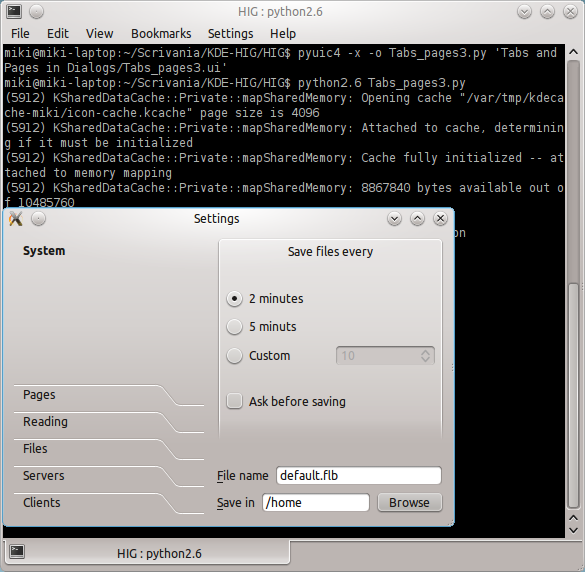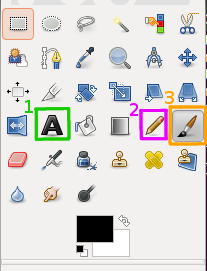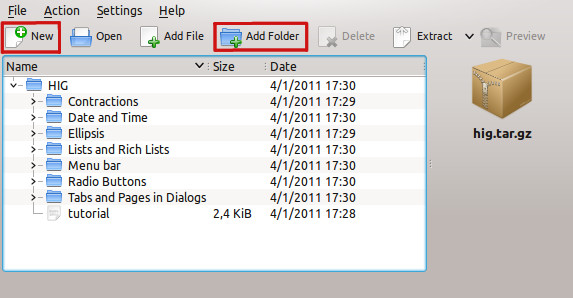Projects/Usability/HIG/UI Files: Difference between revisions
No edit summary |
|||
| Line 1: | Line 1: | ||
The aim of this tutorial is to explain how to create and modify screenshots for the [] | |||
==UI Files== | ==UI Files== | ||
UI files are used by '''Qt Designer''' and '''Qt Creator''' for designing ''User Interfaces''. | UI files are used by '''Qt Designer''' and '''Qt Creator''' for designing ''User Interfaces''. | ||
If you want to modify them, you should use Qt Designer, but this is off topic and I link some tutorials for you: | |||
* [http://sector.ynet.sk/qt4-tutorial/my-first-qt-gui-application.html A somewhat old tutorial] | |||
And a very very good video-tutorial: | |||
* [http://www.youtube.com/watch?v=LYF0spYkXUs&feature=related Part I] | |||
* [http://www.youtube.com/watch?v=E7Ud6FonsR4 Part II] | |||
==How to | ==How to compile UI files== | ||
In order to use your interfaces, you have to compile these files into a Python or C++ application. For this tutorial I have chosen Python. | In order to use your interfaces, you have to compile these files into a Python or C++ application. For this tutorial I have chosen Python. | ||
| Line 48: | Line 55: | ||
</code> | </code> | ||
Here a screenshot: | Here is a screenshot: | ||
[[File:UI-Package-Example.png]] | [[File:UI-Package-Example.png]] | ||
==How to take and annotate a screenshot== | |||
To take a screenshot, you can use [http://docs.kde.org/development/en/kdegraphics/ksnapshot/index.html KSnapshot], which is included in standard KDE distributions. | |||
Press the '''''Stamp R Sist''''' button: | |||
[[File:Stamp_R_Sist.jpg]] | |||
to open KSnapshot and set the options up. I use these options: | |||
* ''Capture Mode'' -> Window Under Cursor | |||
* ''Snapshot Delay'' -> 1-2 seconds | |||
* ''Include window decorations'' -> True | |||
If you need extra space you may want to use: | |||
* ''Capture Mode'' -> Region | |||
Now press ''New Snapshot'', take your snapshot and save it somewhere. | |||
If you want to annotate your screenshot you can use [http://www.gimp.org/ Gimp]. Install it with this simple command: | |||
<code> | |||
$ sudo apt-get install gimp | |||
</code> | |||
Open it and start drawing! I usually use brushes to draw circles, arrows, etc., pencil to draw sharp lines and text tool to insert text: | |||
[[File:Gimp-Screenshot.png]] | |||
Notes: | |||
# Text Tool | |||
# Pencil | |||
# Brush | |||
==How to create an archive== | |||
In this tutorial I will use [http://docs.kde.org/stable/en/kdeutils/ark/index.html Ark], but you can use any software you like! | |||
Ark is a very simple program: open it and create a new archive clicking on ''New''. Click on ''Add folder'' and select the folder containing the .ui files and all the screenshots. | |||
[[File:Ark-Screenshot.png]] | |||
Revision as of 17:27, 4 January 2011
The aim of this tutorial is to explain how to create and modify screenshots for the []
UI Files
UI files are used by Qt Designer and Qt Creator for designing User Interfaces. If you want to modify them, you should use Qt Designer, but this is off topic and I link some tutorials for you:
And a very very good video-tutorial:
How to compile UI files
In order to use your interfaces, you have to compile these files into a Python or C++ application. For this tutorial I have chosen Python.
Obviously, you need Python. On KUbuntu, it can be installed with this command (in your terminal):
$ sudo apt-get install python2.6
You have to compile your .ui files with the pyuic4 tool. Make sure you have the pyqt4-dev-tools package installed. On KUbuntu, just open the terminal and type:
$ sudo apt-get install pyqt4-dev-tools
This will check if the package is installed. If not it will installed automatically.
Now you can compile the .ui file into a Python file! Simply run the following command:
$ pyuic4 -x -o output.py input.ui
Notes:
- -x tells pyuic4 to generate extra code to directly test and display the GUI
- -o sets the output file
To display the GUI, you only have to run Python:
$ python2.6 output.py
Example
Let's compile Tabs and Pages in Dialogs/Tabs_pages3.ui from File:HIG-UI-Files.tar.gz. Decompress the tarball and run:
$ cd path/to/the/extracted/tarball
$ pyuic4 -x -o Tabs_pages3.py 'Tabs and Pages in Dialogs/Tabs_pages3.ui'
Now run it through Python:
$ python2.6 Tabs_pages3.py
Here is a screenshot:
How to take and annotate a screenshot
To take a screenshot, you can use KSnapshot, which is included in standard KDE distributions. Press the Stamp R Sist button:
to open KSnapshot and set the options up. I use these options:
- Capture Mode -> Window Under Cursor
- Snapshot Delay -> 1-2 seconds
- Include window decorations -> True
If you need extra space you may want to use:
- Capture Mode -> Region
Now press New Snapshot, take your snapshot and save it somewhere.
If you want to annotate your screenshot you can use Gimp. Install it with this simple command:
$ sudo apt-get install gimp
Open it and start drawing! I usually use brushes to draw circles, arrows, etc., pencil to draw sharp lines and text tool to insert text:
Notes:
- Text Tool
- Pencil
- Brush
How to create an archive
In this tutorial I will use Ark, but you can use any software you like!
Ark is a very simple program: open it and create a new archive clicking on New. Click on Add folder and select the folder containing the .ui files and all the screenshots.




